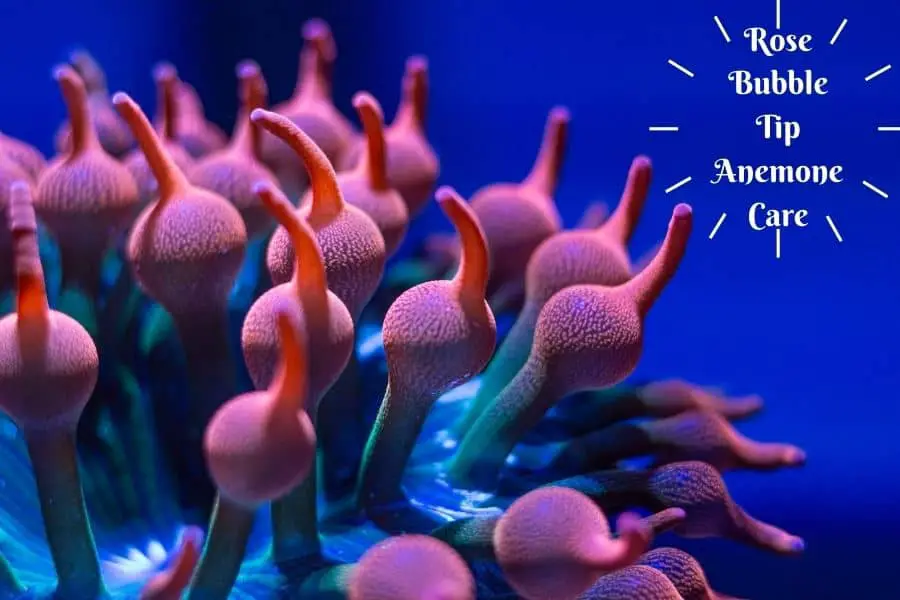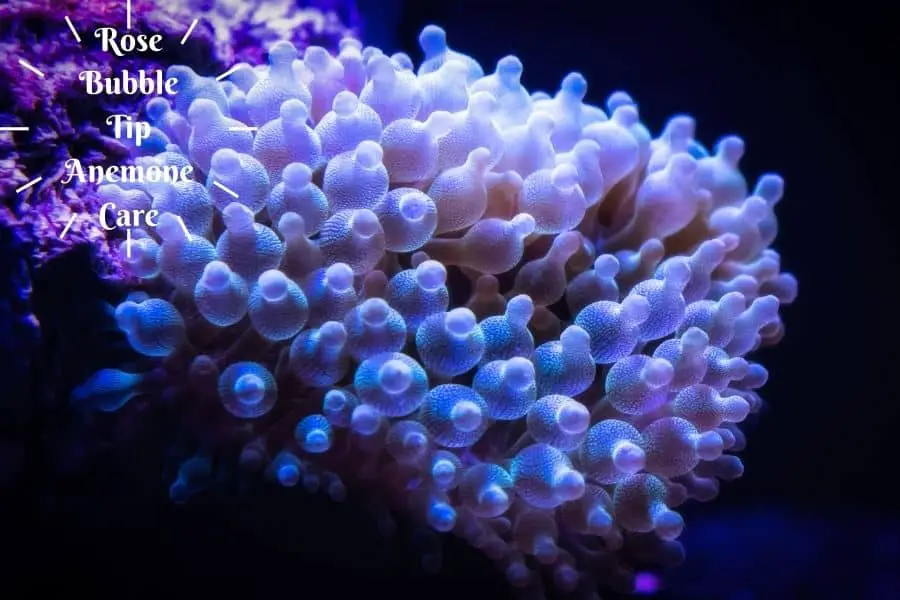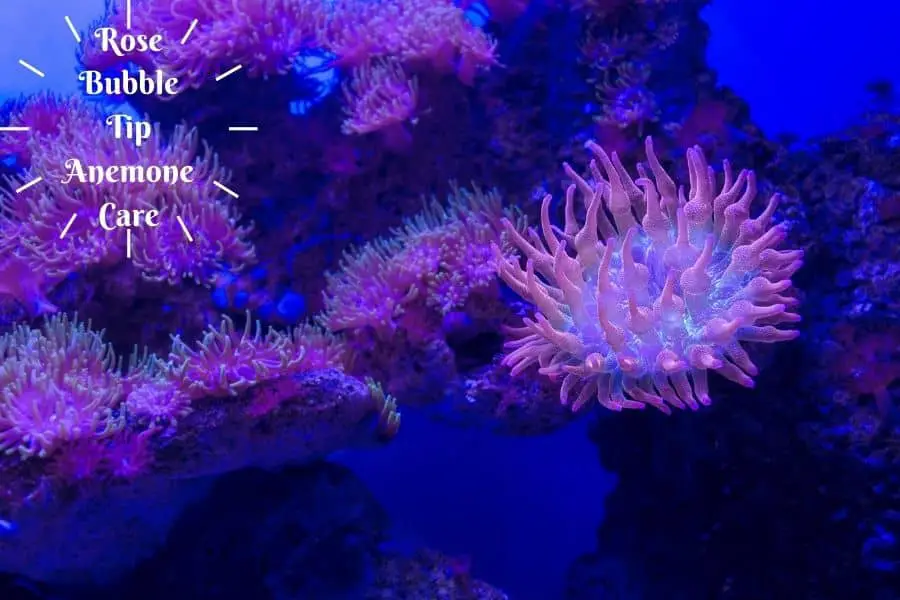Rose bubble tip anemone is a most beautiful member of the anemone family. The good news is, that you can keep them in your aquarium easily. But before adding them to your collection, it is essential to have the proper knowledge. So, I will share my knowledge and experience about this beautiful creature.

Quick Overview
Jump To
- 1 Quick Overview
- 2 One Look Care Guide
- 3 The Appearance Of Rose Bubble Tip Anemone
- 4 Behavior
- 5 Rose Bubble Tip Anemone and Clownfish
- 6 Special note:
- 7 Tankmates Of Rose Bubble Tip Anemone
- 8 Tank requirements
- 9 Size of the tank
- 10 Water quality
- 11 Special note
- 12 Flow Rate
- 13 Lighting
- 14 How To Place Them In A Tank
- 15 How Long Do They Live?
- 16 How To Frag Or Propagate
- 17 How Fast Do Rose Bubble Tip Anemone Grows
- 18 What Do Rose Bubble Tip Anemone Eat
- 19 Predators Of Rose Bubble Tip Anemone
- 20 Why are Rose Bubble Tip Anemones Losing their Color?
- 21 Why Rose Bubble Tip Anemone Splitting
- 22 Why Is Rose Bubble Tip Anemone Dying?
- 23 Source
Rose bubble tip anemone got this name based on rose appearance and color. They are popular among aquarists due to their less common appearance. Moreover, These anemones need a minimum requirement to survive in an aquarium. Their scientific name is Entacmaea quadricolor, and they are a member of the family Actiniidae. People recognize the Rose bubble tip anemone from other different names. They are:
- Rose anemone
- Bubble tentacle anemone
- Bubble tip anemone
However, the Rose bubble tip anemone is a species that is pretty easy to keep in the aquarium. It is widely spread in tropical waters of the Indo-Pacific, including the Red sea. In the wild, These anemones typically live in either coral rubble or solid reef. These rocky structures help them to attach their pedal disks.
One Look Care Guide
| Scientific name | Entacmaea quadricolor |
| Common name | Rose bubble tip anemone Rose anemone Bubble tentacle anemone Bubble tip anemone |
| Care level | Easy |
| Reef Compatible | Reef safe |
| Native to | Indo Pacific including the Red sea |
| Color | Rich rose to red color |
| Tank size | 2 inches anemone – 30 gallons tank 4 inches anemone – 50 gallons tank 6 to 8 inches anemone– 75 gallons tank 12 inches adult anemone– 100 gallons or more tank |
| Preferred temperature | 72-83 Fahrenheits (22.2 to 28.3 Celsius) |
| Water parameters | Calcium- 380-430 ppm, The ideal level is 420 ppm Magnesium – 1250-1350 ppm pH level 8.1 to 8.4 Alkalinity level 7 to11 dKH or 2.5 to 3.9 meq/L the ideal level is 10 dKH (3.5 meq/L) Phosphate All compounds should be below 10 ppm Nitrate, Nitrite, Ammonia – ideal level : 0 ppm |
| Preferred salinity | 1.023 to 1.025 specific gravity |
| Size | 12 inches or |
| Growth rate | No exact growth rate |
| Temperament | Semi-aggressive |
| Recommended tank mates | Clownfish Juvenile Dascyllus trimaculatus Shrimps like Periclimenes brevicarpalis |
| Preferred food | Silverside Krill Mussels Fish Shrimps Worms Frozen food carnivore preparations Other meaty items |
| Feeding frequency | 3 to 4 times per week |
| Propagation by | Sexually and asexually |
The Appearance Of Rose Bubble Tip Anemone

This bubble tip anemone ranges from rich rose to red color. Rose bubble tip anemones’ tentacles have unusual bubble formation. There is an enlarged tip at the end of the tentacle. Rose bubble tip anemones can change the size and length of the tentacles based on their environment. These anemones lack the iconic bulbous tip. There is an enlarged tip at the end of the tentacle. The size and the shape of the bubble also can be varied. Thus, they have a stringy look.
When they live in the deeper water of the ocean with low lighting conditions, they enlarge their tentacles. This type has a stringy look. You can see this in the aquarium with low lighting conditions too. But in captivity, they have short tentacles. The size and the shape of the bubble also can be varied. The foot of the Rose bubble tip anemone is situated below the splay of tentacles.
This delicate foot contains muscle fibers, and they use to move and attach to the substrates. The mouth of the Rose bubble tip anemone is situated in the center. The mouth will open when hungry, and it is an oval shape.
Special note: Scientists could not identify the exact reason for the formation of the bubbles of bubble tip anemone.
But there are several assumptions.
- Some scientists say that bubble formation derives from the requirement for more lighting.
- Some explain it as a requirement for more feeds.
Behavior
- The behavior of the Bubble tip anemone is similar to the other anemones. They have simple behavior, and this anemone type is not very active.
- Rose bubble tip anemone is semi-aggressive.
- They have a better symbiotic relationship with the clownfish.
- If the area where you place them does not have an ideal condition, they tend to move around the aquarium and search for the perfect place.
Rose Bubble Tip Anemone and Clownfish
There is a symbiotic relationship between the Rose bubble tip anemone and clownfish. This relationship gives benefits to both parties. These are:
- In the wild, they help each other to fulfill nutrient requirements. More or less, it also happens in captivity.
- Clownfish and These anemones protect each other from predators.
However, you can not keep all clownfish with the Rose bubble tip anemone. You can rear:
- Clark’s Clownfish (Amphiprion clarkii)
- Tomato Clownfish (Amphiprion frenatus)
- Three-band Clownfish (Amphiprion tricinctus)
- Allard’s Clownfish (Amphiprion allardi)
- Maroon Clownfish (Premnas biaculeatus)
- Oman Clownfish (Amphiprion omanesis)
- Orange-fin Clownfish (Amphiprion chrysopterus)
- Barrier Reef Clownfish (Amphiprion akindynos)
- Two-band Clownfish (Amphiprion bicinctus)
- Red Saddleback Clownfish (Amphiprion ephippium)
- Red and black Clownfish (Amphiprion melanopus)
- McCulloch’s Clownfish (Amphiprion mccullochi)
- Australian Clownfish (Amphiprion rubrocinctus)
Special note:
- If you wish to keep clownfish with the Rose bubble tip anemone, you should be highly concerned about both species’ sizes.
- These anemones should be 3 to 4 larger in diameter than the length of the clownfish. Example: 4 to 6 inches anemone – 1 to 1.5 inches clownfish
- Also, it would be best if you placed your Rose bubble tip anemone in the aquarium for a few months to introduce the clownfish into your collection.
Tankmates Of Rose Bubble Tip Anemone
Apart from clownfish, you can keep the following two species with these anemones.
- Juvenile Dascyllus trimaculatus
- Shrimps like Periclimenes brevicarpalis
You can keep other anemones as a tankmate of your Rose bubble tip anemone. But you should arrange enough space for them. If not, it can be chemical warfare.
Special note In addition to the above species, if you want to keep other species with these anemones, you should be highly aware of the particular species. If not, it can be a risk for both species.
Tank requirements
When you rear any anemone, including a Rose bubble tip anemone, you must be careful about tank requirements because it is the home where anemones will live. Apart from that, You should perform a water change according to the bellow chart. It helps to keep the quality of the water.
| Bi-monthly | 10% water change |
| Monthly | 20% water change |
- You should change the water at any time when nitrate levels rise to 10 ppm.
- You should keep the live rock in the aquarium.
- Live rock is an excellent biological filter.
- It is an excellent base to attach the Rose bubble tip anemone.
- Live rock support anemones to take more light by allowing them to climb upon them.
- The recommendation is 1.5 to 2.0 lbs. of live rock per gallon of water.
- You can use any substrate, but the best one is a sand substrate.
- It would be best to place other corals within several inches of distance from the Rose bubble tip anemone because anemones tend to sting the coral by using their tentacles.
- If you expect to add These anemones to your aquarium, the tank should be 9 to 12 months old and stable.

Size of the tank
The minimum tank requirement for a Rose bubble tip anemone is 25-50 gallons. But it depends on the size of These anemones.
| Rose bubble tip anemone Size | Minimum tank size |
| 2 inches | 30 gallons |
| 4 inches | 50 gallons |
| 6 to 8 inches | 75 gallons |
| 12 inches | 100 gallons or more |
You can rear Rose bubble tip anemones in Nano tanks. But if you can provide a large aquarium for These anemones, it is the best. Do not try to crib them in a small tank.
Special Note: A protein skimmer is an essential piece of equipment for the aquarium.
Water quality
Water temperature: Temperature is a critical factor that can directly influence anemones. Maintain water temperature between 72 oF -83 oF using an aquarium heater (22.2 to 28.3 oC).
The pH level of water: They like slightly alkaline water. Thus, you should maintain a pH level between 8.1-8.4.
The salinity of the water: The water salinity level should be the same as the ocean water salinity. They prefer to live in water that has 1.023-1.025 Specific gravity or 35ppt.
Alkalinity level of water: It should be 7-11 dKH (2.5 to 3.9 meq/L). The ideal level is 10 dKH (3.5 meq/L)
Calcium Level: You should maintain a calcium level of around 380-430 ppm. The ideal calcium level is 420 ppm.
Magnesium level: Anemones prefer water that has 1250-1350 ppm magnesium.
Ammonia, Nitrates, Nitrites: You should keep these parameters at zero levels. Anemones can survive until these parameters exceed 10 ppm. You should use proper management practices and maintain procedures to protect your anemones and fish from the above toxic compounds.
Special note
- You can use a recommended dosing pump to keep the water quality. The dosing pump can alleviate the manual dosing of the water with Calcium, alkalinity, and magnesium 2-4 times a week.
- Also, you can use Purigen and Poly-fiber to keep the quality of your aquarium water.
- It is better to check and adjust the magnesium level before you use the calcium test.
Flow Rate
Rose bubble tip anemone requires moderate water flow to live healthily and happily. Let them away from direct flows because they like subtle movements. High flow rates cause you to stretch out and look stringy of your anemone.
Lighting
When you rear Rose bubble tip anemone, lighting is one of the most critical factors. They need moderate to high lighting conditions. The following things can help you reach an ideal lighting condition.
01. Metal halides
| 150W Metal halide | 25 gallons tank |
| 120W VHO | 25 gallons tank |
| 500W Metal halide | 150 gallons tank |
02. A set of VHA or PC
03. T5 fluorescent bulbs
04. Blue LEDs
05.14-20K color spectrum
They require strong lighting conditions to thrive because of the following requirements.
- Rose bubble tip anemone is a photosynthetic animal. It means rose bubble anemones can absorb the lights to synthesize their foods.
- To eliminate the bleaching. Bleaching can lead to the death of an anemone. There are zooxanthellae in the body of these anemones.
There is a symbiotic relationship between them. Poor lighting condition badly affects this relationship, and it causes to expel the zooxanthellae. Because of that, the anemone turns white.

How To Place Them In A Tank
- You should go through the acclimation process to help the rose bubble anemone to adjust the new environment before placing. The drip method is better for coral species to acclimate.
- You should turn off the water flow before placing the Rose bubble tip anemone. After attaching them to a rock or crevice, the anemone, you can increase the water flow.
- When placing them, you should leave 3 cm and 5 cm space between anemone and corals.
- But sometimes, anemone tends to move toward the corals. At this time, you can move corals away from them
- You should minimize the handling of anemones as much as possible.
- Generally, they stop the move when they find the perfect place to settle.
How Long Do They Live?
The life span of the Rose bubble tip anemone is unknown. They live hundreds of years in their natural environment. But in captivity, their life span reduces by about 80 years. But you can increase their lifespan by providing proper care.
How To Frag Or Propagate
Propagate or frag is pretty easy in captivity. Rose bubble tip anemones increase their population sexually and asexually.
Sexual reproduction
Sexual reproduction is the same as others. Through this, create swimming lava by combining sperms and eggs. But you can experience this method rarely in captivity.
Asexual Reproduction
Another method is fission. These anemones split into two different animals. You can motivate them to divide by feeding them properly. Also, they tend to split due to stress. In addition to that, aquarists propagate them artificially. They cut anemones in half and attach them to the rock. If you want to do this, make sure that the anemone is in good health. But my opinion is, let them reproduce naturally.
Related : Bubble Tip Anemone (Entacmaea quadricolor) 9 Important Care Facts
Related : Rock Flower Anemone | Beautiful Rock Flowers To Your Aquarium |
How Fast Do Rose Bubble Tip Anemone Grows
Rose bubble tip anemone can grows up to 12 inches as an adult. But there is no specific growth rate. The growth of the anemone depends on several factors.
- Foods
- Lighting condition
- Water flow
- Water parameters
You can reach a reasonable growth rate by providing ideal conditions to your Rose bubble tip anemone.
What Do Rose Bubble Tip Anemone Eat
This anemone is a carnivore. Therefore, they accept animal matters.
In the wild, they eat;
- Since Rose bubble tip anemones are photosynthetic animals, they collect daily nutrients through zooxanthellae.
- They catch prey from their venomous cells, nematocysts.
- They grab nutrients from the water.
- Anemones consume the waste of resident fish species like clownfish.
In captivity, they eat;
- Silverside
- Krill
- Mussels
- Fish
- Shrimps
- Worms
- Frozen carnivore preparations
- Other meaty items
Special note: By feeding with quality and nutrients rich foods, you can increase the color and overall health of these anemones.
How To Feed Them
- Take a small cup and fill it with aquarium water.
- Soak the diet of the water in the cup.
- Wait about 20-30 minutes
- Place the food at the end of the tweezer or stick.
- Then touch the bubble tip anemone with it.
- Anemone grabs the food from their sticky tentacles.
- Do not poke the stick or tweezer into the anemone. It can damage the columns of the anemone.
Feeding Frequency
Generally, you should feed them 3 to 4 times per week. But feeding frequency is varied with the size and age of the Rose bubble tip anemone. You should daily feed younger anemones and sick anemones that lost their zooxanthellae.
Special note: It is a myth that anemones need food once a month. This belief is false, and this can kill your anemone.
After Feeding
After feeding, you should remove the uneaten food particles from the tank. A filter system plays a vital role to remove excess foods. If you allow the uneaten foods to decompose, they will produce harmful by-products such as ammonia, nitrates, and nitrites. These will cause to reduce water conditions in the aquarium.
Predators Of Rose Bubble Tip Anemone
- Nudibranchs :Nudibranchia
- Sea stars :Asterias rubens
- Crown-of-thorns starfish: Acanthaster planci or COTS
- Angelfish: Pterophyllum
- Other anemones :Actiniaria
- Bristle worms: Polychaeta
Why are Rose Bubble Tip Anemones Losing their Color?
The main reason is poor lighting conditions, which causes to bleach the anemones. There are zooxanthellae in the body of the Rose bubble tip anemone. There is a symbiotic relationship between them. Poor lighting condition badly affects this relationship, and it causes to expel the zooxanthellae. Because of that, the anemone turns white. This process is called bleaching, and it can kill the Rose bubble tip anemone.
Why Rose Bubble Tip Anemone Splitting
Splitting is a self-preservation method. Also, in captivity, splitting is an asexual reproduction method. You can use it to enhance anemones’ future population.
Why Is Rose Bubble Tip Anemone Dying?
- If rose bubble anemone has a disease and you do not give proper treatment, they will die.
- Poor lighting condition causes bleaching them. Bleaching can kill the Rose bubble tip anemone.
- Insufficient water parameters also can badly affect the anemone. They are unable to survive in unfavorable water quality parameters.
- Anemones cannot suddenly adjust to the new environment if you did not follow the acclimating process properly. It gives enormous stress to a newcomer.
- Predatory activities can be a reason to die rose bubble anemones.
Related : Do Clownfish Need Anemones to Live?
Related : Acanthophyllia Coral Definitive Care Guide
